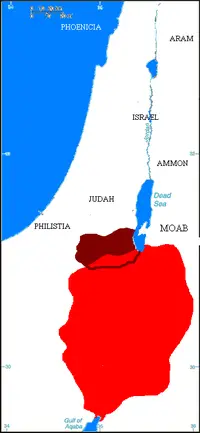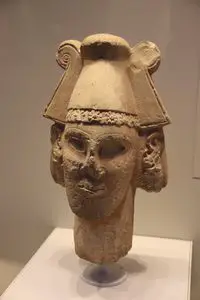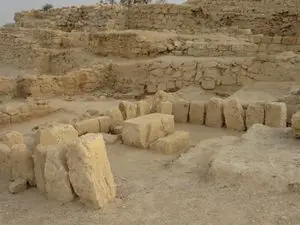Why Were the Ancient Israelites and Edomites Enemies
The ancient Hebrews, who later became the Israelites, had a plethora of enemies throughout their history. Of course the Egyptians, Assyrians, and Babylonians are the best known and were the most powerful of their enemies, but they had numerous other foes. The Philistines were their primary enemy when the Kingdom of Israel was being created and the Neo-Hittites were a common enemy at the height of their power. The Edomites, though, hold the distinction of being the enemy of the Hebrews and the Israelites from the earliest time of Hebrew history in the Bronze Age until the Kingdom of Judah was destroyed by the Neo-Babylonian Empire in the sixth century BC.
The enmity the Israelites had for the Edomites was deep and for the most part mutual. In order to understand the enduring conflict between the Israelites and Edomites, it is important to separate the reasons given in the primary sources into two categories: spiritual reasons and political factors. Once those ideas are considered, then it will become clear that the Israelites and Edomites actually had more in common than not and that the true reason for their eternal struggle against each other had to do with the most valuable commodity in the ancient Levant – land.
Spiritual Reasons for the Hebrew-Edomite Conflict
Ancient Edom stretched from the southern shore of the Dead Sea to the Gulf of Aqaba, with deserts on either side, roughly marking the east and west boundaries. The Old Testament of the Bible – which along with archaeological work comprises the majority of the primary source information on the Edomites – states that Esau, who “is Edom,” dwelt with his people on Mount Seir. [1] Modern archaeologists believe that the region where Mount Seir was located formed the northern and most populous part of Edom, while the southern, more rugged part was more of a wilderness with far fewer people. [2]
The biblical origins of the Israelite-Edomite conflict can be found in the book of Genesis, long before there were Israelites or Edomites. According to Genesis, Israel and Edom were descended from the twin sons of Isaac and Rebekah, Jacob and Esau. The book states that the twins were never equal, even when they were still in the womb.
“Two nations are in thy womb, and two manner of people shall be separated from they bowels; the other people; and the elder shall serve the younger.” [3]
Although Esau originally had the birthright of Israel, he sold it to Jacob for some porridge when he was hungry. [4] From that point forward, the brothers lived apart from each other and become the progenitors of their tribes – Esau for the Edomites and Jacob for the Hebrews. The Old Testament may help explain some of the hostility between the two groups, but it provides little concrete evidence for hostilities.
Beginning in the Late Bronze Age, the two peoples had repeated contact that often ended in violence. The reasons for the conflict can only be understood by examining the historical books of the Old Testament within the context of the archaeological discoveries from the Levant.
Historical Reasons for the Israelite-Edomite Conflict
The first historical point of conflict between the Hebrews and Edomites took place in the Late Bronze Age, around the year 1200 BC, when the Hebrews left Egypt in the Exodus. As the Hebrews wandered throughout the Sinai Desert on their way to what would become their home in Canaan, they had to pass through Edom. According to the book of Numbers (20:17-20), the Edomites denied the Hebrews passage through their land. Modern biblical scholars such as Kitchen believe that the unknown Edomite king did this because he was unhappy that Hebrews approached from the west, which was land the Edomites claimed. [5] Nothing else is mentioned and the Hebrews turned around and found a different route.
The book of Deuteronomy (2:1-8), though, states that the Hebrews were in fact allowed to pass through Edom. This apparent inconsistency is rectified by modern scholars through understanding the political geography of ancient Edom. The Edomite king who initially barred the Hebrews entry into his kingdom controlled the northern section of the land around Mount Seir, while the Edomites who allowed them to pass were in the southern, wilderness region of Edom. [6] The circuitous route coincides with most of the likely Exodus routes, which would have sent the Hebrews through the town of Ezlon-geber on the shores of the Gulf of Aqaba before turning north and skirting the western edge of Edom.
The Edomites’ Conflicts with Israel and Judah
The Edomites transitioned from a primarily nomadic society to a more or less stationary state around the same time that the states of Moab, Ammon, and Israel formed in the same region. [7] There are no signs of conflict between Edom and Israel in this period immediately before 1000 BC, and many scholars have suggested that early Edom and Israel shared many cultural affinities.
Although little is known about Edomite religion, the Israelite’s god was probably known in Edom and shared attributes with the Edomites’ primary god. The Edomites may also have worshipped the Israelite god and shared some of the Israelites’ rituals, but this is unknown. [8] It is known, though, that there was no theological or religious conflict between the two peoples. By the time the Edomites and Israelites transitioned into kingdom states, land became a commodity that was exploited and taken by force if need be, which proved to be at the core of the Israelite-Edomite conflict.
When Israel became a kingdom around the year 1000 BC, Saul, the first king of Israel, campaigned against Edom. [9] According to the Old Testament, it was Saul’s successor, David, who conquered Edom and, after doing so, installed permanent garrisons to ensure the Edomites would be compliant.
“And David gat him a name when he returned from smiting of the Syrians in the valley of salt, being eighteen thousand men. And he put garrisons in Edom; throughout all Edom he put garrisons, and all they of Edom became David’s servants. And the Lord preserved David whithersoever he went.” [10]
The Edomites were the subject people of Israel for several decades, until King Solomon, David’s successor, died in 928 BC. After the famous king’s death, Edom rebelled as Israel split into two kingdoms: Israel in the north with Samaria as its capital and Judah in the south governed from Jerusalem. [11] The split meant that Edom was independent for a time, but it also then had to deal with the Kingdom of Judah and a resurgent Egypt.
At the beginning of King Rehoboam of Judah’s (ruled ca. 931-915 BC) reign and the end of King Shoshenq I’s (reigned 945-924 BC) rule, the latter king led a major military campaign into the Levant that he commemorated in the Karnak Temple in Thebes, Egypt. The text lists over 150 localities that the Egyptians attacked and plundered, including several locations in Judah and “Adema,” which is believed to have been Edom. [12] The campaign is also detailed in the Old Testament books of 1 Kings (14:25-26) and 2 Chronicles (12:2-9). Shoshenq’s campaign may have temporarily devastated both Judah and Edom, but the Edomites took the opportunity to make a permanent break from Judah. [13]
After Shoshenq I’s foray into the Levant, neither Judah nor Israel was able to reassert their hegemony over the region, although both tried. The Assyrians first began moving into the territory during the rule of Adad-nirari II (810-783 BC). Then other Assyrian kings followed, with Shalmaneser V (reigned 726-722 BC) beginning a long siege of Israel that ended with Sargon II (ruled 722-705 BC) taking most of Israel’s population into captivity. Judah escaped the Assyrian scourge but fell victim to a similar fate in 587-586 BC at the hands of the Neo-Babylonian king, Nebuchadnezzar II (reigned 604-562 BC). After Nebuchadnezzar took the population of Judah captive to Babylon, the Edomites quickly occupied Judah. [14] The event was chronicled in the books of Obadiah and Lamentations, where curiously the Edomites are referred to as brothers of the Israelites.
“For thy violence against thy brother Jacob shame shall cover thee, and thou shalt be cut off forever. In the day that the strangers carried away captive his forces, and foreigners entered into his gates and cast lots upon Jerusalem, even thou wast as one of them. But thou shouldest not have looked on the day of thy brother in the day that he became a stranger; neither shouldest thou have rejoiced over the children of Judah in the day of their destruction.” [15]
So Why Were the Edomites and Israelites Enemies?
An examination of the biblical, archaeological, and Near Eastern sources reveals that the Edomites and Israelites had a close, yet contentious relationship throughout their long history. According to the Bible, the two tribes were literally born with enmity toward each other. A closer examination reveals that the source of their conflict was more about the resources than religion. The Edomites and Israelites fought over land.
As both tribes grew into kingdoms, they struggled for land and power in a region where good land was scarce, so military conflict was quite common. When Israel prospered from about 1000 to 724 BC, the Edomites were in a weaker political position. When the Assyrians and Neo-Babylonians became the preeminent powers in the region, the Edomites were able to take advantage by extending their influence in Judah. The Bible chroniclers were no doubt influenced in a negative way by the Edomites’ move into Judah, so a group that was already viewed somewhat negatively became one of the most notorious enemies of the Israelites.
References
- Jump up ↑ Gen. 36:8
- Jump up ↑ Kitchen, Kenneth A. On the Reliability of the Old Testament. (Grand Rapids, Michigan: William B. Eerdmans, 2003), p. 194
- Jump up ↑ Gen. 25:23-24
- Jump up ↑ Gen. 25:29-34
- Jump up ↑ Kitchen, p. 195
- Jump up ↑ Glatt-Gilad, David A. “The Re-Interpretation of the Edomite-Israelite Encounter in Deuteronomy II.” Vestus Testamentum. 47 (1997) p. 443-5
- Jump up ↑ Kuhrt, Amélie. The Ancient Near East: c. 3000-330 BC. (London: Routledge, 2010), p. 416
- Jump up ↑ Assis, Elie. “Why Edom? On the Hostility Towards Jacob’s Brother in Prophetic Sources.” Vestus Testamentum. 56 (2006) p. 437
- Jump up ↑ 1 Sam. 14:47
- Jump up ↑ 2 Sam. 8:11-14
- Jump up ↑ Kuhrt, p. 456
- Jump up ↑ Breasted, James Henry, ed. and trans. Ancient Records of Egypt. Volume 4: The Twentieth trough the Twenty-sixth Dynasties. (Champaign, Illinois: University of Illinois Press, 2001), p. 352
- Jump up ↑ Campbell Junior, Edward F. “A Land Divided: Judah and Israel from the Death of Solomon to the Fall of Samaria.” In The Oxford History of the Biblical World. Edited by Michael Coogan. (Oxford: Oxford University Press, 2001), p. 437
- Jump up ↑ Assis, p. 5
- Jump up ↑ Obad. 1:10-14


